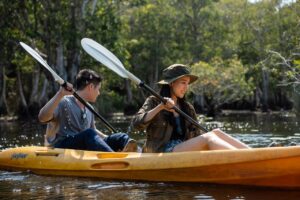World of Kayaking: History & Types
Kayaking is a versatile and exciting water sport that offers a unique combination of adventure, physical challenge and spectacular scenery. Rooted in ancient traditions, kayaking has evolved into a popular activity enjoyed by enthusiasts around the world. Operating a single-seater boat requires not only physical strength and skill, but also a certain state of mind from the paddler.
History and Popularity of Kayaking
Kayaking traces its origins back thousands of years to the indigenous peoples of the Arctic regions, including the Inuit, Aleut, and Yupik, who developed the kayak as a means of hunting and transportation. These early kayaks were made from wood frames covered with animal skins, designed to navigate the icy waters of the Arctic with stealth and efficiency.
In the mid-19th century, kayaking began to gain recognition as a recreational activity in Europe, particularly in Germany and France. John MacGregor, a Scottish lawyer and explorer, played a pivotal role in popularizing the sport with his book “A Thousand Miles in the Rob Roy Canoe,” which documented his extensive kayaking journeys across Europe and the Middle East.
Today, kayaking is a widely enjoyed sport, with millions of participants worldwide. It has become a staple of outdoor recreation, offering everything from serene paddles on calm lakes to adrenaline-pumping white-water adventures.
Types of Kayaking
Kayaking encompasses a variety of styles, each offering its own unique challenges and experiences:
- Recreational Kayaking: Ideal for beginners and casual paddlers, recreational kayaking involves paddling on calm waters such as lakes, slow-moving rivers, and coastal areas. It emphasizes stability and ease of use.
- White-Water Kayaking: This adrenaline-fueled variant involves navigating fast-flowing rivers and rapids. White-water kayakers use specialized boats designed for maneuverability and durability in rough conditions.
- Sea Kayaking: Also known as ocean kayaking, this type involves paddling in open water, including coastal areas, bays, and even open seas. Sea kayaks are typically longer and more robust, designed to handle waves and currents.
- Touring/Expedition Kayaking: This style focuses on long-distance paddling, often over multiple days. Touring kayaks are equipped with storage compartments for gear and supplies, allowing paddlers to embark on extended journeys.
- Kayak Fishing: Combining the tranquility of kayaking with the thrill of fishing, kayak fishing has grown in popularity. Anglers use specially designed kayaks equipped with fishing gear and accessories.
Key Locations and Events
Kayaking is celebrated through numerous events and locations worldwide, each offering unique experiences and challenges:
- Colorado River, USA: Known for its stunning landscapes and thrilling rapids, the Colorado River is a premier destination for white-water kayaking.
- Sea of Cortez, Mexico: Offering crystal-clear waters and abundant marine life, this location is ideal for sea kayaking and snorkeling.
- Devizes to Westminster International Canoe Race, UK: One of the most challenging endurance kayaking events, this race covers 125 miles from Devizes to Westminster.
- Fjords of Norway: Famous for their breathtaking beauty, the fjords of Norway provide a majestic backdrop for sea kayaking adventures.
Start the Kayaking Adventure!
Kayaking offers a huge variety for all kinds of people. You can choose from extreme races on steep mountain rivers or prefer a relaxing fishing trip or a walk in the Norwegian Fjords. All you need to join the global kayaking movement is a willingness to learn new things and not be afraid to expand your horizons. In addition to scenic views, exciting adventures are waiting for you, which will also help you get your physical and mental state back to normal.
